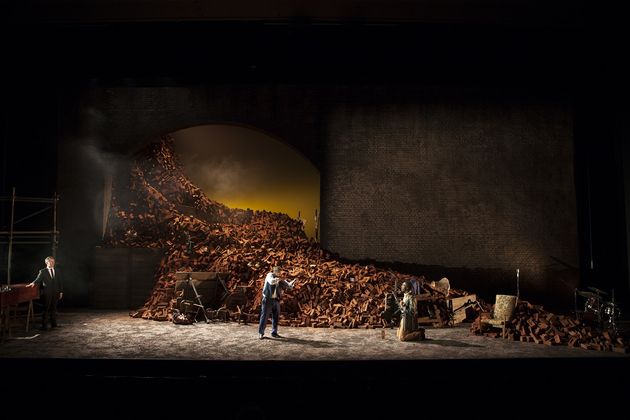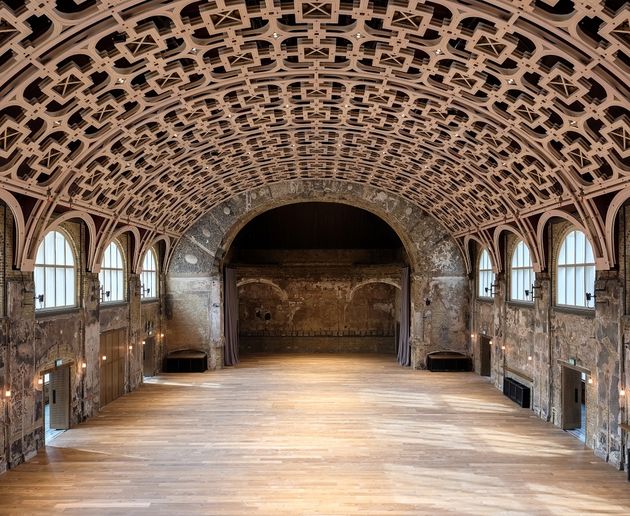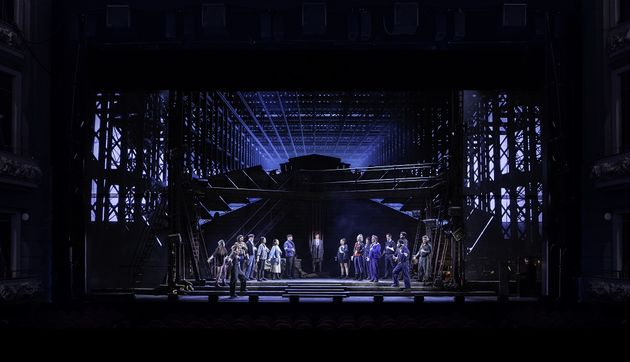The London production of War Horse gained awards and great acclaim for its impressive set design. Photo by Brinkhoff & Mogenburg
As architecture becomes more performative, set design is becoming more real. Edwin Heathcote explores the age of the stage
In architecture, the idea of a stage set might appear as a kind of insult, conjuring up connotations of Potemkin villages and paper-thin facades on Wild West towns. But the differences between the spectacular and the solid, performance and reality, collapsed in the 1960s, with Guy Debord’s The Society of Spectacle and in Robert Venturi and Denise Scott-Brown’s response to Las Vegas as an authentic expression of popular culture. If Vegas was authentic, then the set for a Liberace or a Beyoncé extravaganza was, surely, just as much a part of the canon of contemporary culture.
The stage was once a refuge where fantastic designs could be realised – dreamscapes, toy towns, visions of fairies and sugar plums alongside hellish nightmares – without impinging on reality. CGI, the theme park and the increasing ability of contemporary architecture to realise even the most outlandish forms has meant that reality often outstrips the stuff on the stage. This is, arguably, leading to a collapsing of the boundaries between stage and city.
Diller Scofidio + Renfro designed the High Line in New York as urban adaptation, but also deliberately turned the city into theatre (even including a set of steps to watch the traffic from) and then staging and directing the Mile-Long Opera in 2018. Meanwhile, Renzo Piano designed the new Academy Museum of Motion Pictures in Los Angeles, a museum of film and 1,000-seat theatre, for the self-celebration of Hollywood. Is the world of architecture colliding with the stage and the movies, or is one eating the other?
Starchitects are flattered by invitations on stage, suckers for a bouquet. In recent years, Frank Gehry has designed crumpled paper sets for Don Giovanni inside his own Walt Disney Hall in LA; Jean Nouvel took on The Marriage of Figaro and Zaha Hadid designed Così fan tutte at the same venue. In addition, Herzog & de Meuron did Verdi’s Attila at the Met in New York and Daniel Libeskind has been known to look far more comfortable on the opera stage than he does on the construction site.
 59 Productions designed the set for Northern Stages theatrical production of Get Carter. Photo courtesy of 59 Productions
59 Productions designed the set for Northern Stages theatrical production of Get Carter. Photo courtesy of 59 Productions
Stage sets and architecture have, historically, been intimately intertwined. The Greeks, the Romans and the architects of the Renaissance, the Baroque and the Rococo were all obsessed with the architecture of the stage set. The theatre was a metaphor for life, but more than that, a condensed and intensified realm in which ideas about aspects of society such as politics, morality and ethics that were otherwise considered to be dangerous could be played out with a freedom that did not exist in the real-world space of the town square.
Yet since the end of the pioneering period of modernism, when the Bauhaus, the German expressionists and the Russian constructivists all used theatre to promote their radical aesthetic ideas (which were often unrealisable in the chaos of reality and the lack of technology and money), set design has been sidelined, its protagonists remaining relatively unknown.
Today, that may be changing. Architecture has become an art of spectacle. Nouvel’s designs for the Louvre Abu Dhabi and the Qatar National Museum are as much scenography as they are architecture. The rise of figures including Thomas Heatherwick and Bjarke Ingels – designers shorn of the existential angst and social conscience of the generation before them – is pulling architecture towards a kind of urban decoration, the dressing up of corporate monoliths as pseudo-public play spaces. This is something that has been happening for a while. Jon Jerde’s malls in the 1990s, for example, brilliantly blended film-set fantasy with raw commercial consumerism, and Zaha Hadid’s buildings collapsed the boundaries between rendering and reality.
![]() Part of The Shed, bottom left, and the Vessel, centre, in Hudson Yards, New York. Photo by Toa Heftiba
Part of The Shed, bottom left, and the Vessel, centre, in Hudson Yards, New York. Photo by Toa Heftiba
As the worlds created for gaming and the movies have become both more fantastic and more real, there has been a simultaneous growth of the experience economy. Perhaps because home ownership has become an increasingly distant dream for the young, they have been investing their spare income in real experience rather than real estate. A rock gig which might once have featured a few fireworks is now a travelling circus of tech and performers. Beyoncé’s show at Coachella, which has itself become a Netflix hit, was designed by gig producers Stufish, harking back almost to the choreography of the 1930s musicals and Busby Berkeley spectaculars. As recording sales collapse, the gig becomes again the prime source of revenue.
The desire for the big event, the operatic and the Gesamtkunstwerk feeds back into building. The recently opened Shed in New York, a part realisation of the 1960s fantasy of the flexible cultural hangar, was co-designed by David Rockwell, who himself gained prominence in set design, and Elizabeth Diller, who began in the performance-based art scene of 1970s New York. Adjacent to it is Heatherwick’s Vessel, a piece of set design masquerading as architecture. It appears to have no function other than as a stage for selfies.
Although architects are muscling in on set design, this is arguably a golden age for production designers themselves. We are, perhaps, living through the reaction to the reaction. If the orthodoxy for a while was a kind of theatrical existenzminimum, using the raw brick of the building or the immediacy of in the round, there is now an increasing use of the spectacular. This is perhaps to justify skyrocketing ticket prices, but also because more movies are being adapted to stage and need to appeal to a different audience.
 The Grand Hall at Battersea Arts Centre by Haworth Tompkins, where every space opens up to performance. Photo by Fred Howarth
The Grand Hall at Battersea Arts Centre by Haworth Tompkins, where every space opens up to performance. Photo by Fred Howarth
Es Devlin has become the most formidable name among them. Her spellbinding designs for The Lehmann Trilogy (initially at the National Theatre then transferred to the Piccadilly Theatre in May) and for last year’s Coachella combine the spectacular and the intimate, amplifying the presence and humanity of tiny humans on the big stage. Her being chosen to represent the UK at the Expo 2020 in Dubai feels like an acknowledgement that such events are about the spectacular more than the purely architectural.
Theatre designer Bunny Christie’s work, notably recently for The Curious Incident of the Dog in the Night Time, which is still showing, Ink (2017) and The Red Barn (2017) are utterly unforgettable. 59 Productions add video into the mix (including for the London Olympics and War Horse). Thomas Bird, Tom Piper, Rae Smith, Soutra Gilmour and dozens of other theatre designers have propelled London stage sets in particular to the top of the tree. It also appears to be a field where women can assert themselves more than in architecture.
And then, after the spectacular, we are left with the city itself; now a simulacrum and a tourist spectacle, created for consumption as much as for accommodation. It is the background for passion plays, installations and choreographed protests. What was the Oxford Circus Extinction Rebellion if it wasn’t a theatrical event?
 Sting’s musical The Last Ship, featuring set and video design by 59 Productions. Photo by 59 Productions
Sting’s musical The Last Ship, featuring set and video design by 59 Productions. Photo by 59 Productions
Finally, we return to the building. There can be few more fascinating theatre buildings of recent years than the Battersea Arts Centre, a one-time town hall reimagined as a machine to performance and rehearsal by Haworth Tompkins, in which every space opens itself out to any imaginable activity. There is no front and back of house, but even the smallest of rooms becomes a theatre space, a potential venue for experimentation or performance. The scars and damage to the building are preserved, its history of inhabitation inscribed in its walls.
There, amid the damaged plaster and cracked terrazzo, is the wallpaper from a performance of Punchdrunk’s Edgar Allan Poe adaptation, The Masque of the Red Death, in which the building became as much a part of the ensemble as the actors and the audience. It is in such tropes that theatre leaves its mark and that its architecture becomes a physical and psychological palimpsest of performance and memory.
The original version of the article appeared in Icon 194, the August 2019 edition about performativity and design

















